Competitive Strategy: Analysis of Key Strategy Development Tools
VerifiedAdded on 2022/09/17
|7
|2011
|22
Essay
AI Summary
This essay provides a comprehensive analysis of three key strategy development tools: SWOT analysis, PESTEL analysis, and Porter's Generic Strategies. The introduction emphasizes the importance of strategic planning for business viability and growth. The SWOT analysis examines internal strengths and weaknesses and external opportunities and threats, illustrated with an example of Woolworths. The PESTEL analysis assesses the external environment by considering political, economic, social, technological, legal, and environmental factors, also exemplified by Woolworths. Finally, Porter's Generic Strategies, including cost leadership, differentiation, and focus, are discussed, with Starbucks used as a case study for differentiation. The essay concludes by reiterating the value of these tools in understanding a company's competitive position and facilitating strategic planning for long-term success. The essay follows the assignment brief provided, which required a discussion of three strategy models with practical applications.
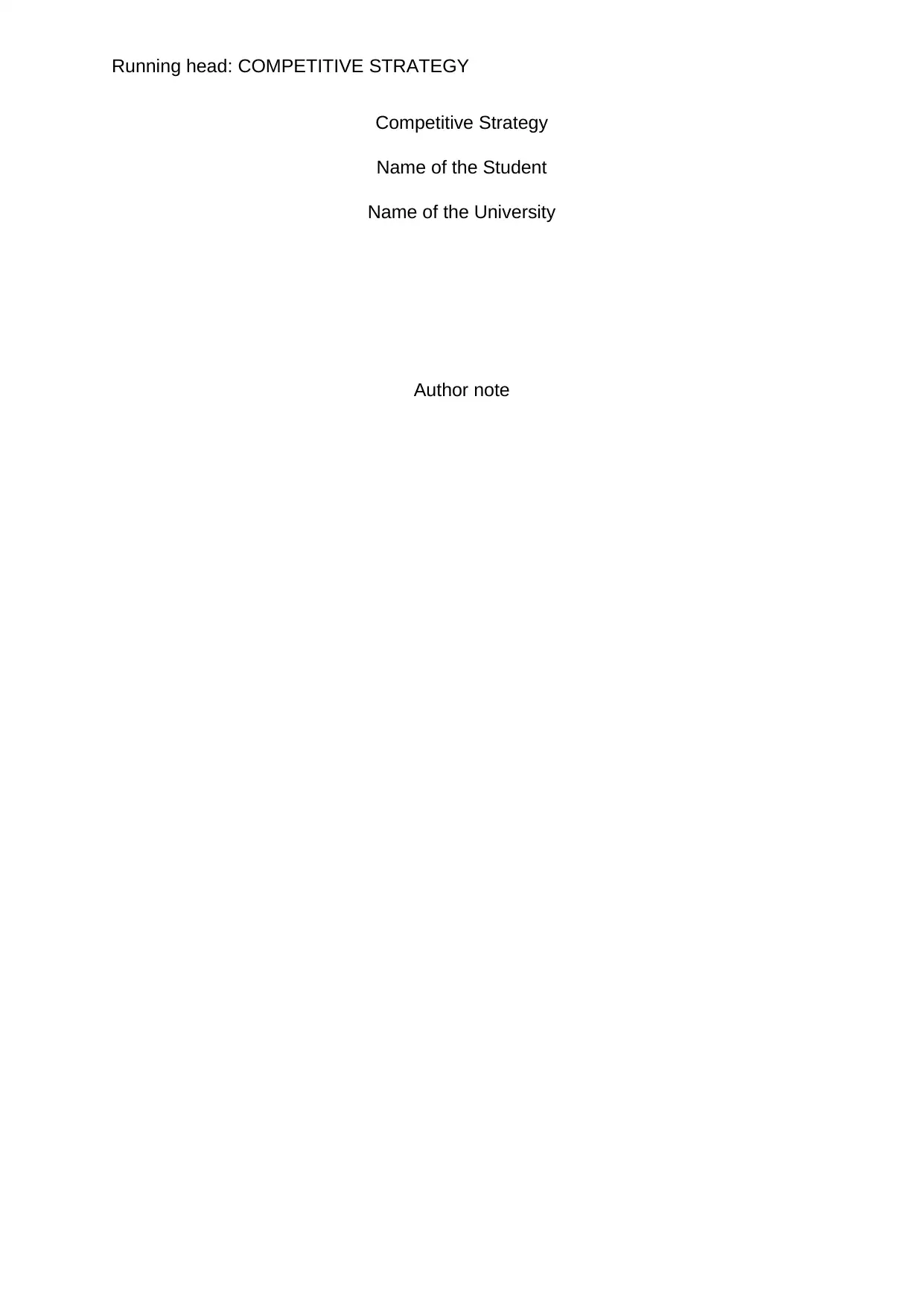
Running head: COMPETITIVE STRATEGY
Competitive Strategy
Name of the Student
Name of the University
Author note
Competitive Strategy
Name of the Student
Name of the University
Author note
Paraphrase This Document
Need a fresh take? Get an instant paraphrase of this document with our AI Paraphraser
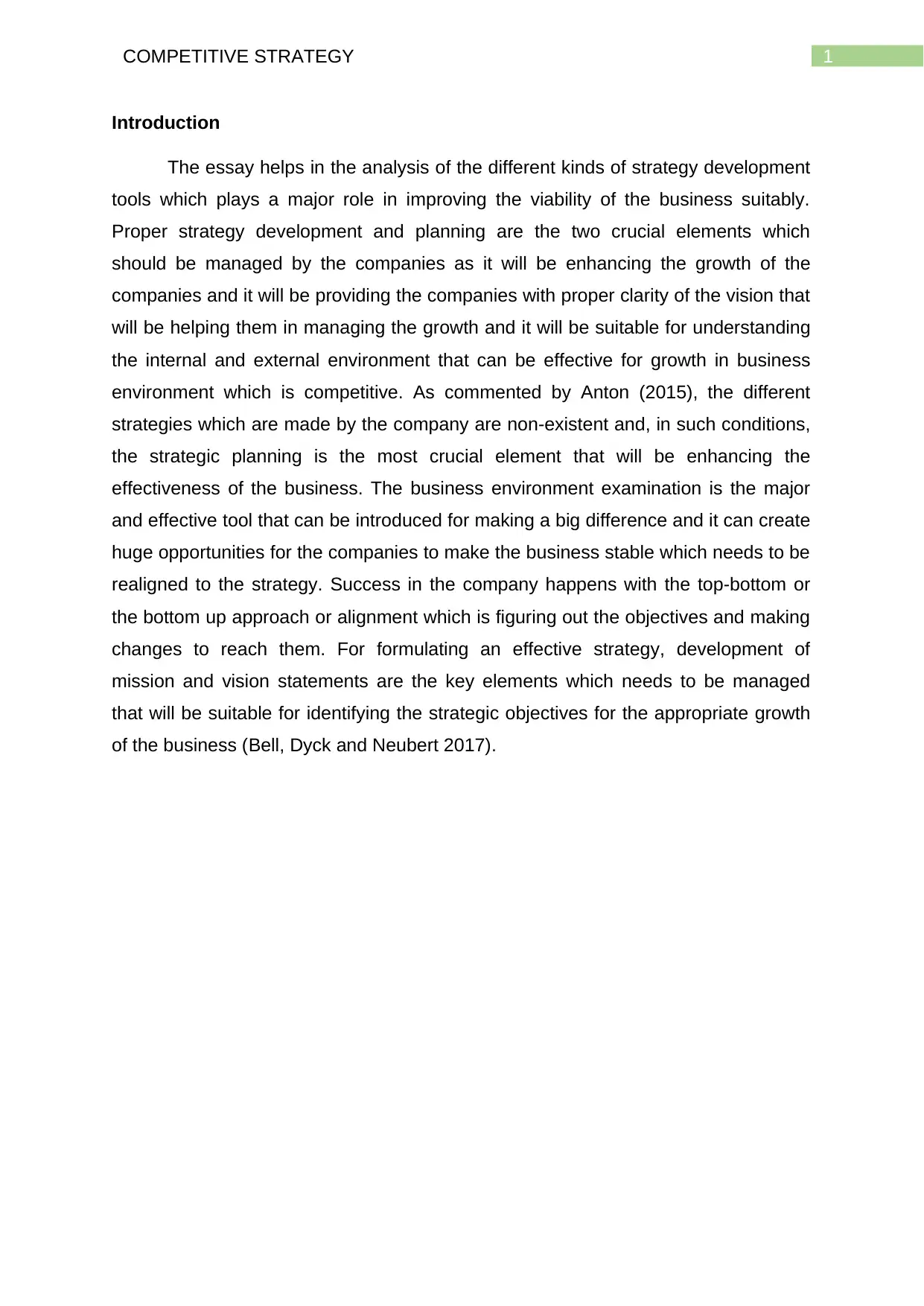
1COMPETITIVE STRATEGY
Introduction
The essay helps in the analysis of the different kinds of strategy development
tools which plays a major role in improving the viability of the business suitably.
Proper strategy development and planning are the two crucial elements which
should be managed by the companies as it will be enhancing the growth of the
companies and it will be providing the companies with proper clarity of the vision that
will be helping them in managing the growth and it will be suitable for understanding
the internal and external environment that can be effective for growth in business
environment which is competitive. As commented by Anton (2015), the different
strategies which are made by the company are non-existent and, in such conditions,
the strategic planning is the most crucial element that will be enhancing the
effectiveness of the business. The business environment examination is the major
and effective tool that can be introduced for making a big difference and it can create
huge opportunities for the companies to make the business stable which needs to be
realigned to the strategy. Success in the company happens with the top-bottom or
the bottom up approach or alignment which is figuring out the objectives and making
changes to reach them. For formulating an effective strategy, development of
mission and vision statements are the key elements which needs to be managed
that will be suitable for identifying the strategic objectives for the appropriate growth
of the business (Bell, Dyck and Neubert 2017).
Introduction
The essay helps in the analysis of the different kinds of strategy development
tools which plays a major role in improving the viability of the business suitably.
Proper strategy development and planning are the two crucial elements which
should be managed by the companies as it will be enhancing the growth of the
companies and it will be providing the companies with proper clarity of the vision that
will be helping them in managing the growth and it will be suitable for understanding
the internal and external environment that can be effective for growth in business
environment which is competitive. As commented by Anton (2015), the different
strategies which are made by the company are non-existent and, in such conditions,
the strategic planning is the most crucial element that will be enhancing the
effectiveness of the business. The business environment examination is the major
and effective tool that can be introduced for making a big difference and it can create
huge opportunities for the companies to make the business stable which needs to be
realigned to the strategy. Success in the company happens with the top-bottom or
the bottom up approach or alignment which is figuring out the objectives and making
changes to reach them. For formulating an effective strategy, development of
mission and vision statements are the key elements which needs to be managed
that will be suitable for identifying the strategic objectives for the appropriate growth
of the business (Bell, Dyck and Neubert 2017).
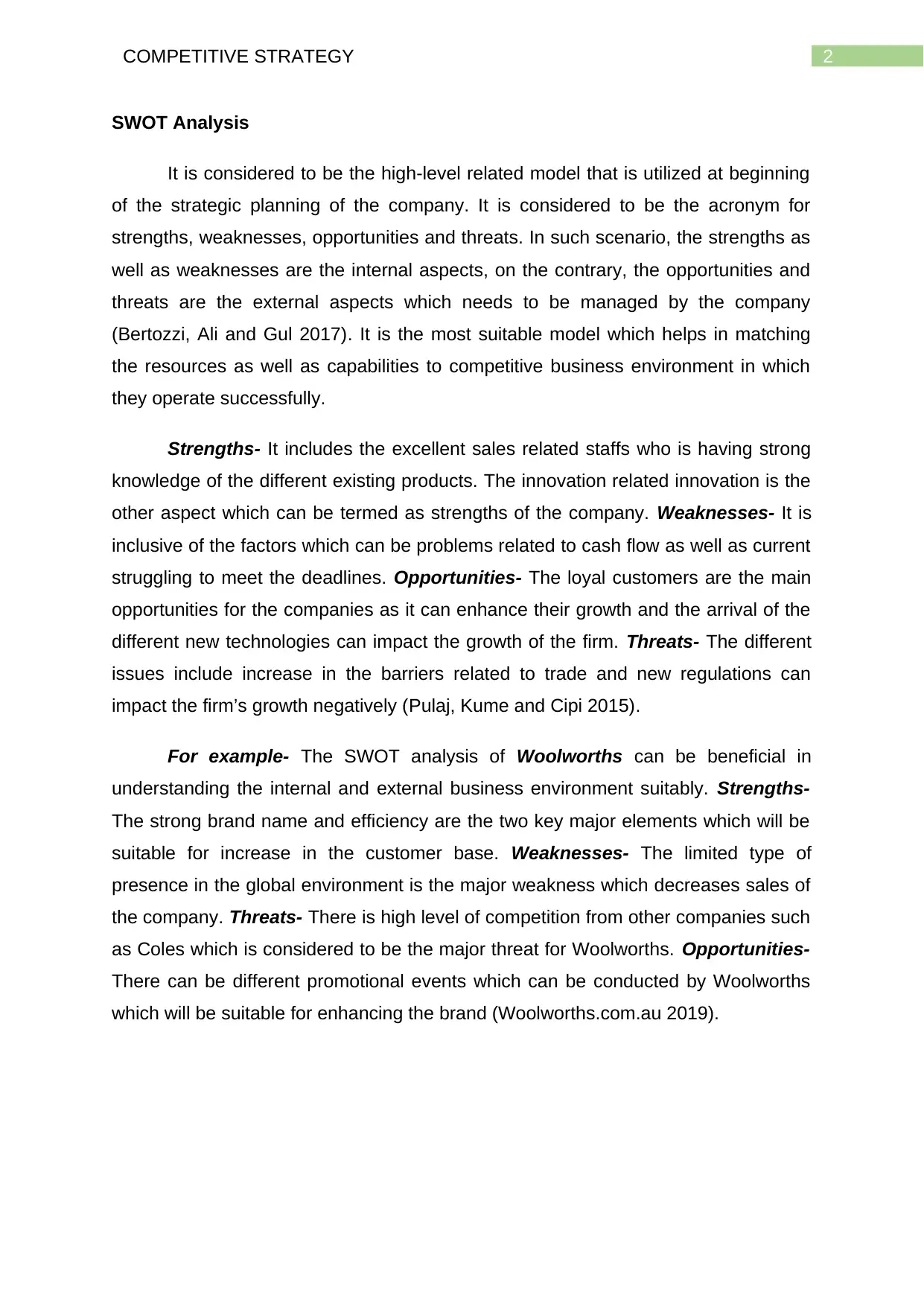
2COMPETITIVE STRATEGY
SWOT Analysis
It is considered to be the high-level related model that is utilized at beginning
of the strategic planning of the company. It is considered to be the acronym for
strengths, weaknesses, opportunities and threats. In such scenario, the strengths as
well as weaknesses are the internal aspects, on the contrary, the opportunities and
threats are the external aspects which needs to be managed by the company
(Bertozzi, Ali and Gul 2017). It is the most suitable model which helps in matching
the resources as well as capabilities to competitive business environment in which
they operate successfully.
Strengths- It includes the excellent sales related staffs who is having strong
knowledge of the different existing products. The innovation related innovation is the
other aspect which can be termed as strengths of the company. Weaknesses- It is
inclusive of the factors which can be problems related to cash flow as well as current
struggling to meet the deadlines. Opportunities- The loyal customers are the main
opportunities for the companies as it can enhance their growth and the arrival of the
different new technologies can impact the growth of the firm. Threats- The different
issues include increase in the barriers related to trade and new regulations can
impact the firm’s growth negatively (Pulaj, Kume and Cipi 2015).
For example- The SWOT analysis of Woolworths can be beneficial in
understanding the internal and external business environment suitably. Strengths-
The strong brand name and efficiency are the two key major elements which will be
suitable for increase in the customer base. Weaknesses- The limited type of
presence in the global environment is the major weakness which decreases sales of
the company. Threats- There is high level of competition from other companies such
as Coles which is considered to be the major threat for Woolworths. Opportunities-
There can be different promotional events which can be conducted by Woolworths
which will be suitable for enhancing the brand (Woolworths.com.au 2019).
SWOT Analysis
It is considered to be the high-level related model that is utilized at beginning
of the strategic planning of the company. It is considered to be the acronym for
strengths, weaknesses, opportunities and threats. In such scenario, the strengths as
well as weaknesses are the internal aspects, on the contrary, the opportunities and
threats are the external aspects which needs to be managed by the company
(Bertozzi, Ali and Gul 2017). It is the most suitable model which helps in matching
the resources as well as capabilities to competitive business environment in which
they operate successfully.
Strengths- It includes the excellent sales related staffs who is having strong
knowledge of the different existing products. The innovation related innovation is the
other aspect which can be termed as strengths of the company. Weaknesses- It is
inclusive of the factors which can be problems related to cash flow as well as current
struggling to meet the deadlines. Opportunities- The loyal customers are the main
opportunities for the companies as it can enhance their growth and the arrival of the
different new technologies can impact the growth of the firm. Threats- The different
issues include increase in the barriers related to trade and new regulations can
impact the firm’s growth negatively (Pulaj, Kume and Cipi 2015).
For example- The SWOT analysis of Woolworths can be beneficial in
understanding the internal and external business environment suitably. Strengths-
The strong brand name and efficiency are the two key major elements which will be
suitable for increase in the customer base. Weaknesses- The limited type of
presence in the global environment is the major weakness which decreases sales of
the company. Threats- There is high level of competition from other companies such
as Coles which is considered to be the major threat for Woolworths. Opportunities-
There can be different promotional events which can be conducted by Woolworths
which will be suitable for enhancing the brand (Woolworths.com.au 2019).
⊘ This is a preview!⊘
Do you want full access?
Subscribe today to unlock all pages.

Trusted by 1+ million students worldwide
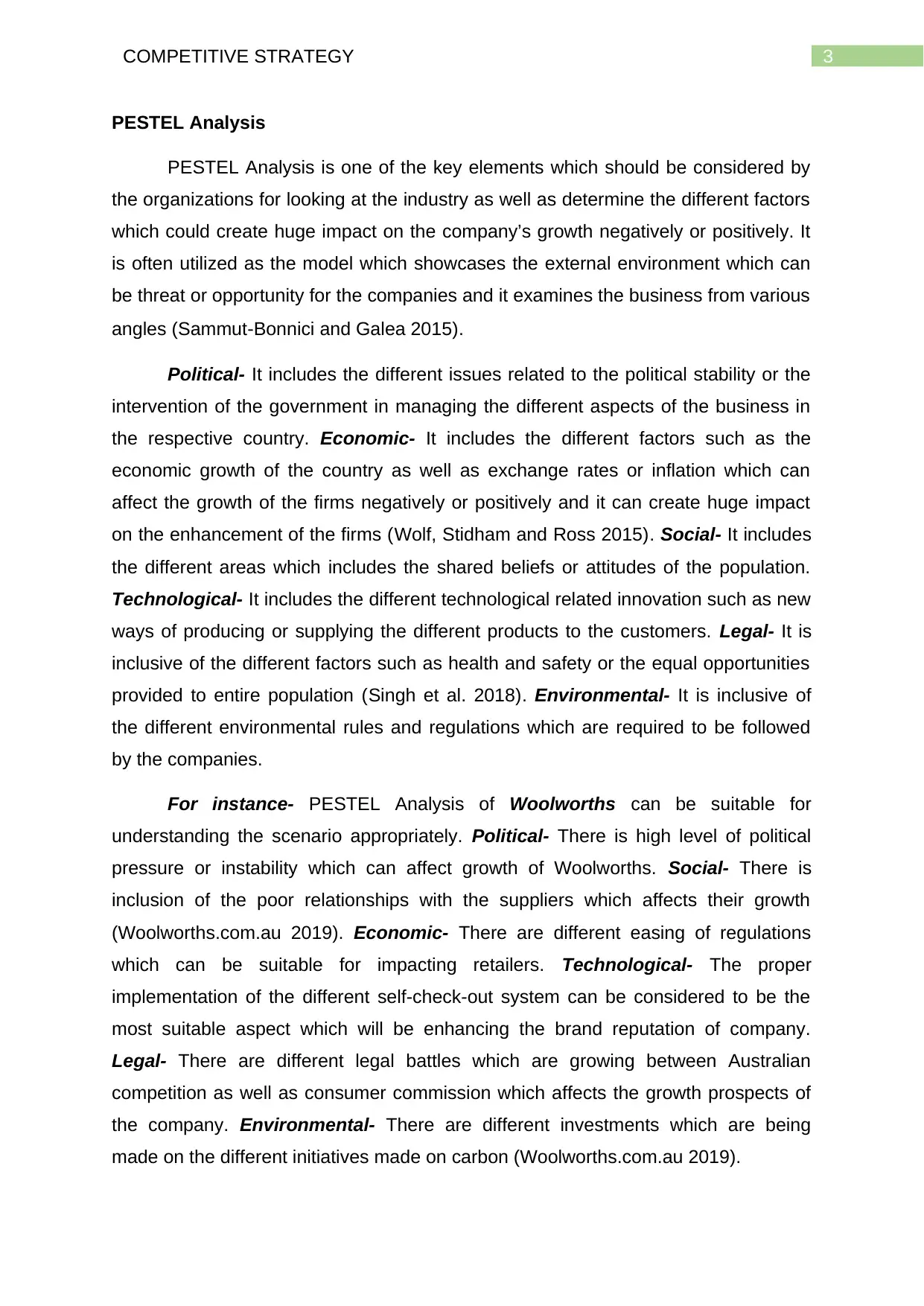
3COMPETITIVE STRATEGY
PESTEL Analysis
PESTEL Analysis is one of the key elements which should be considered by
the organizations for looking at the industry as well as determine the different factors
which could create huge impact on the company’s growth negatively or positively. It
is often utilized as the model which showcases the external environment which can
be threat or opportunity for the companies and it examines the business from various
angles (Sammut‐Bonnici and Galea 2015).
Political- It includes the different issues related to the political stability or the
intervention of the government in managing the different aspects of the business in
the respective country. Economic- It includes the different factors such as the
economic growth of the country as well as exchange rates or inflation which can
affect the growth of the firms negatively or positively and it can create huge impact
on the enhancement of the firms (Wolf, Stidham and Ross 2015). Social- It includes
the different areas which includes the shared beliefs or attitudes of the population.
Technological- It includes the different technological related innovation such as new
ways of producing or supplying the different products to the customers. Legal- It is
inclusive of the different factors such as health and safety or the equal opportunities
provided to entire population (Singh et al. 2018). Environmental- It is inclusive of
the different environmental rules and regulations which are required to be followed
by the companies.
For instance- PESTEL Analysis of Woolworths can be suitable for
understanding the scenario appropriately. Political- There is high level of political
pressure or instability which can affect growth of Woolworths. Social- There is
inclusion of the poor relationships with the suppliers which affects their growth
(Woolworths.com.au 2019). Economic- There are different easing of regulations
which can be suitable for impacting retailers. Technological- The proper
implementation of the different self-check-out system can be considered to be the
most suitable aspect which will be enhancing the brand reputation of company.
Legal- There are different legal battles which are growing between Australian
competition as well as consumer commission which affects the growth prospects of
the company. Environmental- There are different investments which are being
made on the different initiatives made on carbon (Woolworths.com.au 2019).
PESTEL Analysis
PESTEL Analysis is one of the key elements which should be considered by
the organizations for looking at the industry as well as determine the different factors
which could create huge impact on the company’s growth negatively or positively. It
is often utilized as the model which showcases the external environment which can
be threat or opportunity for the companies and it examines the business from various
angles (Sammut‐Bonnici and Galea 2015).
Political- It includes the different issues related to the political stability or the
intervention of the government in managing the different aspects of the business in
the respective country. Economic- It includes the different factors such as the
economic growth of the country as well as exchange rates or inflation which can
affect the growth of the firms negatively or positively and it can create huge impact
on the enhancement of the firms (Wolf, Stidham and Ross 2015). Social- It includes
the different areas which includes the shared beliefs or attitudes of the population.
Technological- It includes the different technological related innovation such as new
ways of producing or supplying the different products to the customers. Legal- It is
inclusive of the different factors such as health and safety or the equal opportunities
provided to entire population (Singh et al. 2018). Environmental- It is inclusive of
the different environmental rules and regulations which are required to be followed
by the companies.
For instance- PESTEL Analysis of Woolworths can be suitable for
understanding the scenario appropriately. Political- There is high level of political
pressure or instability which can affect growth of Woolworths. Social- There is
inclusion of the poor relationships with the suppliers which affects their growth
(Woolworths.com.au 2019). Economic- There are different easing of regulations
which can be suitable for impacting retailers. Technological- The proper
implementation of the different self-check-out system can be considered to be the
most suitable aspect which will be enhancing the brand reputation of company.
Legal- There are different legal battles which are growing between Australian
competition as well as consumer commission which affects the growth prospects of
the company. Environmental- There are different investments which are being
made on the different initiatives made on carbon (Woolworths.com.au 2019).
Paraphrase This Document
Need a fresh take? Get an instant paraphrase of this document with our AI Paraphraser
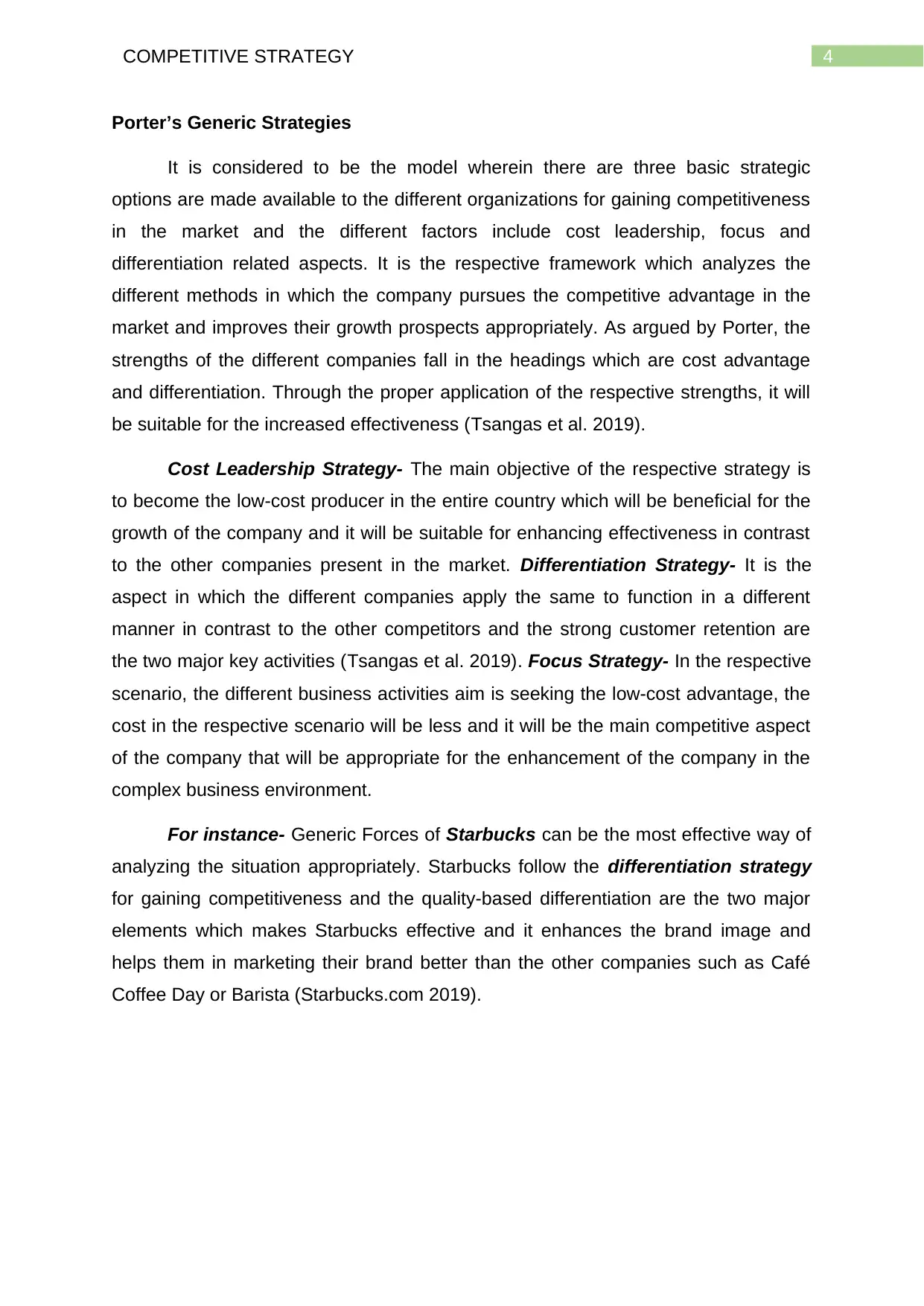
4COMPETITIVE STRATEGY
Porter’s Generic Strategies
It is considered to be the model wherein there are three basic strategic
options are made available to the different organizations for gaining competitiveness
in the market and the different factors include cost leadership, focus and
differentiation related aspects. It is the respective framework which analyzes the
different methods in which the company pursues the competitive advantage in the
market and improves their growth prospects appropriately. As argued by Porter, the
strengths of the different companies fall in the headings which are cost advantage
and differentiation. Through the proper application of the respective strengths, it will
be suitable for the increased effectiveness (Tsangas et al. 2019).
Cost Leadership Strategy- The main objective of the respective strategy is
to become the low-cost producer in the entire country which will be beneficial for the
growth of the company and it will be suitable for enhancing effectiveness in contrast
to the other companies present in the market. Differentiation Strategy- It is the
aspect in which the different companies apply the same to function in a different
manner in contrast to the other competitors and the strong customer retention are
the two major key activities (Tsangas et al. 2019). Focus Strategy- In the respective
scenario, the different business activities aim is seeking the low-cost advantage, the
cost in the respective scenario will be less and it will be the main competitive aspect
of the company that will be appropriate for the enhancement of the company in the
complex business environment.
For instance- Generic Forces of Starbucks can be the most effective way of
analyzing the situation appropriately. Starbucks follow the differentiation strategy
for gaining competitiveness and the quality-based differentiation are the two major
elements which makes Starbucks effective and it enhances the brand image and
helps them in marketing their brand better than the other companies such as Café
Coffee Day or Barista (Starbucks.com 2019).
Porter’s Generic Strategies
It is considered to be the model wherein there are three basic strategic
options are made available to the different organizations for gaining competitiveness
in the market and the different factors include cost leadership, focus and
differentiation related aspects. It is the respective framework which analyzes the
different methods in which the company pursues the competitive advantage in the
market and improves their growth prospects appropriately. As argued by Porter, the
strengths of the different companies fall in the headings which are cost advantage
and differentiation. Through the proper application of the respective strengths, it will
be suitable for the increased effectiveness (Tsangas et al. 2019).
Cost Leadership Strategy- The main objective of the respective strategy is
to become the low-cost producer in the entire country which will be beneficial for the
growth of the company and it will be suitable for enhancing effectiveness in contrast
to the other companies present in the market. Differentiation Strategy- It is the
aspect in which the different companies apply the same to function in a different
manner in contrast to the other competitors and the strong customer retention are
the two major key activities (Tsangas et al. 2019). Focus Strategy- In the respective
scenario, the different business activities aim is seeking the low-cost advantage, the
cost in the respective scenario will be less and it will be the main competitive aspect
of the company that will be appropriate for the enhancement of the company in the
complex business environment.
For instance- Generic Forces of Starbucks can be the most effective way of
analyzing the situation appropriately. Starbucks follow the differentiation strategy
for gaining competitiveness and the quality-based differentiation are the two major
elements which makes Starbucks effective and it enhances the brand image and
helps them in marketing their brand better than the other companies such as Café
Coffee Day or Barista (Starbucks.com 2019).
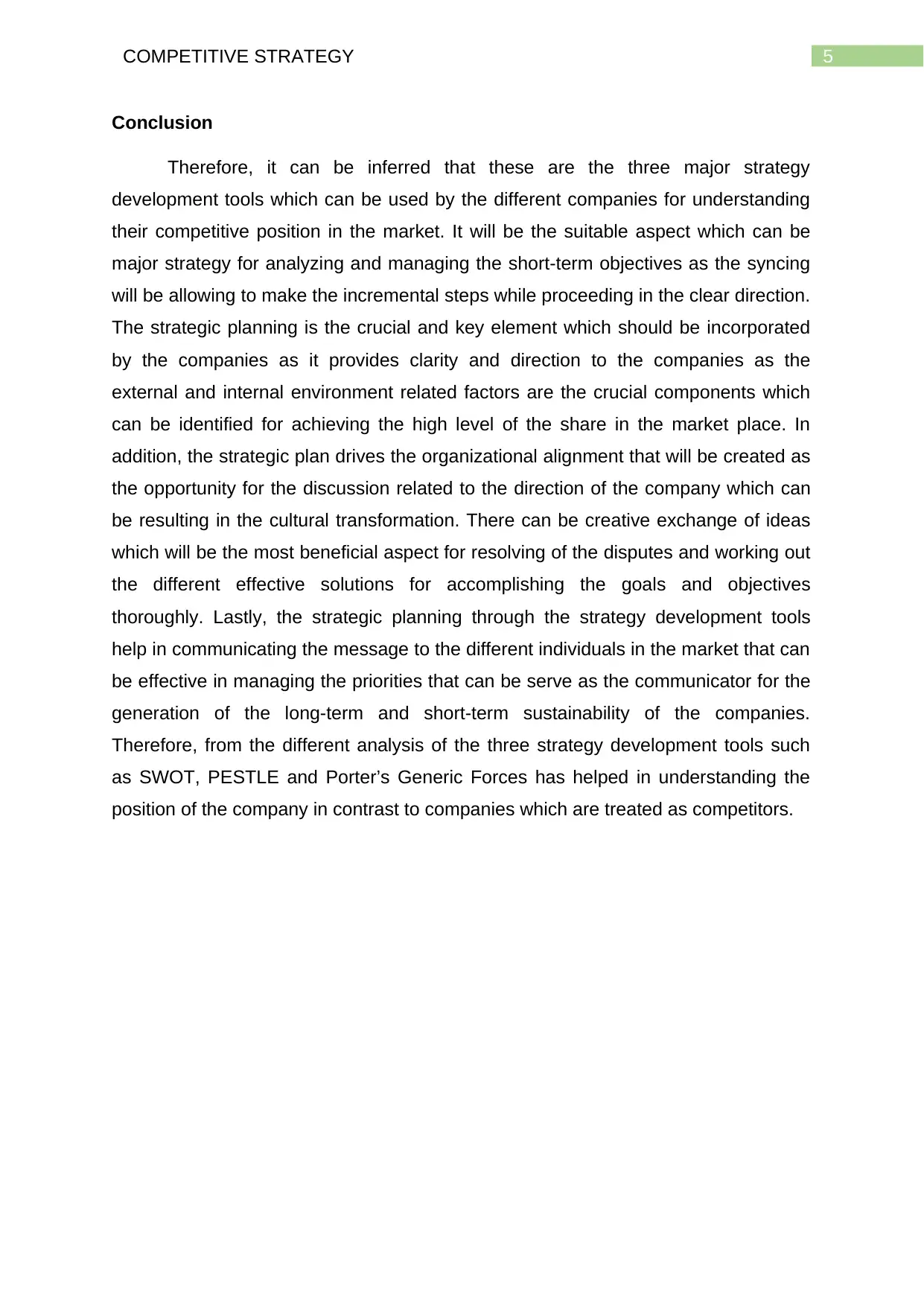
5COMPETITIVE STRATEGY
Conclusion
Therefore, it can be inferred that these are the three major strategy
development tools which can be used by the different companies for understanding
their competitive position in the market. It will be the suitable aspect which can be
major strategy for analyzing and managing the short-term objectives as the syncing
will be allowing to make the incremental steps while proceeding in the clear direction.
The strategic planning is the crucial and key element which should be incorporated
by the companies as it provides clarity and direction to the companies as the
external and internal environment related factors are the crucial components which
can be identified for achieving the high level of the share in the market place. In
addition, the strategic plan drives the organizational alignment that will be created as
the opportunity for the discussion related to the direction of the company which can
be resulting in the cultural transformation. There can be creative exchange of ideas
which will be the most beneficial aspect for resolving of the disputes and working out
the different effective solutions for accomplishing the goals and objectives
thoroughly. Lastly, the strategic planning through the strategy development tools
help in communicating the message to the different individuals in the market that can
be effective in managing the priorities that can be serve as the communicator for the
generation of the long-term and short-term sustainability of the companies.
Therefore, from the different analysis of the three strategy development tools such
as SWOT, PESTLE and Porter’s Generic Forces has helped in understanding the
position of the company in contrast to companies which are treated as competitors.
Conclusion
Therefore, it can be inferred that these are the three major strategy
development tools which can be used by the different companies for understanding
their competitive position in the market. It will be the suitable aspect which can be
major strategy for analyzing and managing the short-term objectives as the syncing
will be allowing to make the incremental steps while proceeding in the clear direction.
The strategic planning is the crucial and key element which should be incorporated
by the companies as it provides clarity and direction to the companies as the
external and internal environment related factors are the crucial components which
can be identified for achieving the high level of the share in the market place. In
addition, the strategic plan drives the organizational alignment that will be created as
the opportunity for the discussion related to the direction of the company which can
be resulting in the cultural transformation. There can be creative exchange of ideas
which will be the most beneficial aspect for resolving of the disputes and working out
the different effective solutions for accomplishing the goals and objectives
thoroughly. Lastly, the strategic planning through the strategy development tools
help in communicating the message to the different individuals in the market that can
be effective in managing the priorities that can be serve as the communicator for the
generation of the long-term and short-term sustainability of the companies.
Therefore, from the different analysis of the three strategy development tools such
as SWOT, PESTLE and Porter’s Generic Forces has helped in understanding the
position of the company in contrast to companies which are treated as competitors.
⊘ This is a preview!⊘
Do you want full access?
Subscribe today to unlock all pages.

Trusted by 1+ million students worldwide
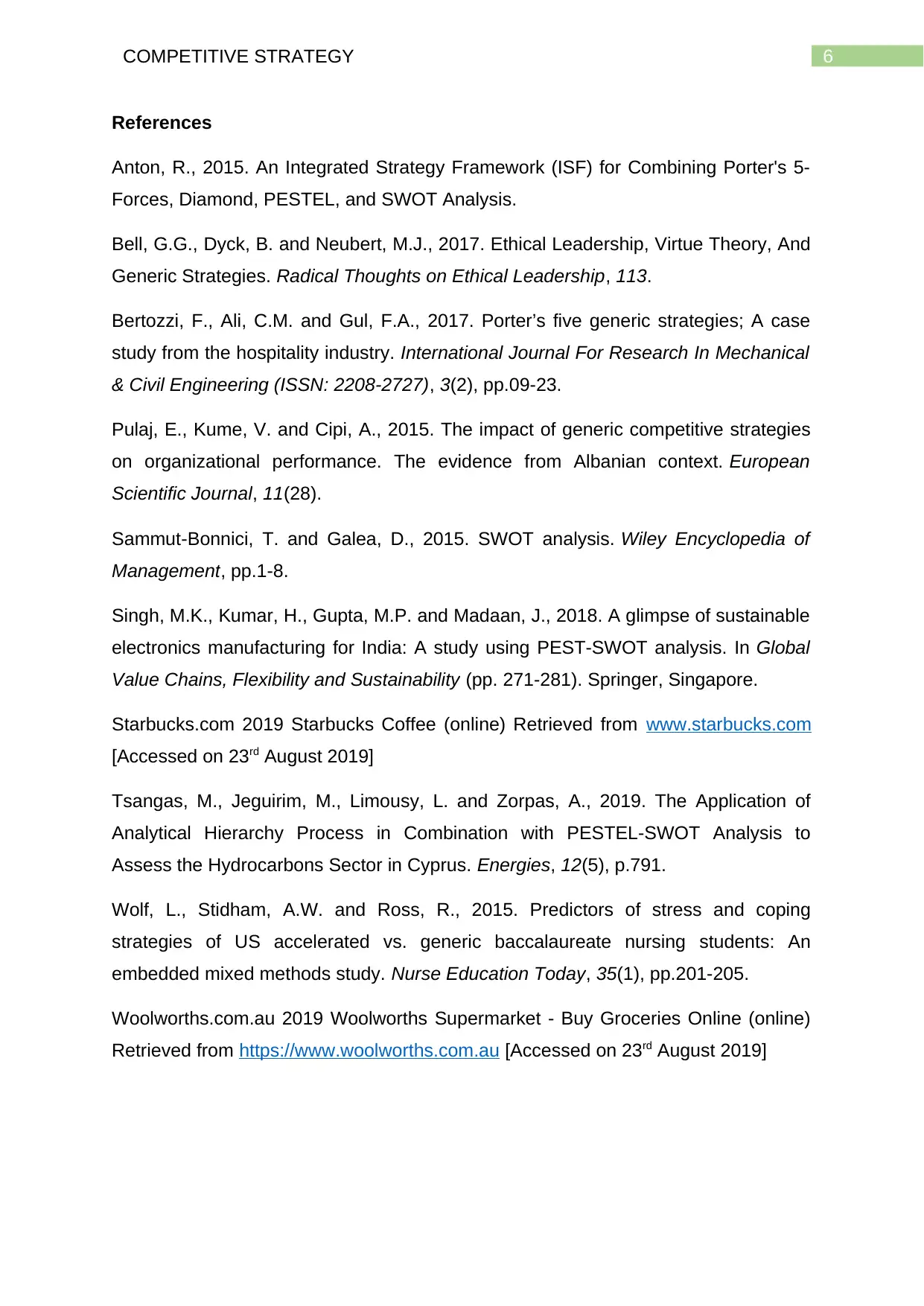
6COMPETITIVE STRATEGY
References
Anton, R., 2015. An Integrated Strategy Framework (ISF) for Combining Porter's 5-
Forces, Diamond, PESTEL, and SWOT Analysis.
Bell, G.G., Dyck, B. and Neubert, M.J., 2017. Ethical Leadership, Virtue Theory, And
Generic Strategies. Radical Thoughts on Ethical Leadership, 113.
Bertozzi, F., Ali, C.M. and Gul, F.A., 2017. Porter’s five generic strategies; A case
study from the hospitality industry. International Journal For Research In Mechanical
& Civil Engineering (ISSN: 2208-2727), 3(2), pp.09-23.
Pulaj, E., Kume, V. and Cipi, A., 2015. The impact of generic competitive strategies
on organizational performance. The evidence from Albanian context. European
Scientific Journal, 11(28).
Sammut‐Bonnici, T. and Galea, D., 2015. SWOT analysis. Wiley Encyclopedia of
Management, pp.1-8.
Singh, M.K., Kumar, H., Gupta, M.P. and Madaan, J., 2018. A glimpse of sustainable
electronics manufacturing for India: A study using PEST-SWOT analysis. In Global
Value Chains, Flexibility and Sustainability (pp. 271-281). Springer, Singapore.
Starbucks.com 2019 Starbucks Coffee (online) Retrieved from www.starbucks.com
[Accessed on 23rd August 2019]
Tsangas, M., Jeguirim, M., Limousy, L. and Zorpas, A., 2019. The Application of
Analytical Hierarchy Process in Combination with PESTEL-SWOT Analysis to
Assess the Hydrocarbons Sector in Cyprus. Energies, 12(5), p.791.
Wolf, L., Stidham, A.W. and Ross, R., 2015. Predictors of stress and coping
strategies of US accelerated vs. generic baccalaureate nursing students: An
embedded mixed methods study. Nurse Education Today, 35(1), pp.201-205.
Woolworths.com.au 2019 Woolworths Supermarket - Buy Groceries Online (online)
Retrieved from https://www.woolworths.com.au [Accessed on 23rd August 2019]
References
Anton, R., 2015. An Integrated Strategy Framework (ISF) for Combining Porter's 5-
Forces, Diamond, PESTEL, and SWOT Analysis.
Bell, G.G., Dyck, B. and Neubert, M.J., 2017. Ethical Leadership, Virtue Theory, And
Generic Strategies. Radical Thoughts on Ethical Leadership, 113.
Bertozzi, F., Ali, C.M. and Gul, F.A., 2017. Porter’s five generic strategies; A case
study from the hospitality industry. International Journal For Research In Mechanical
& Civil Engineering (ISSN: 2208-2727), 3(2), pp.09-23.
Pulaj, E., Kume, V. and Cipi, A., 2015. The impact of generic competitive strategies
on organizational performance. The evidence from Albanian context. European
Scientific Journal, 11(28).
Sammut‐Bonnici, T. and Galea, D., 2015. SWOT analysis. Wiley Encyclopedia of
Management, pp.1-8.
Singh, M.K., Kumar, H., Gupta, M.P. and Madaan, J., 2018. A glimpse of sustainable
electronics manufacturing for India: A study using PEST-SWOT analysis. In Global
Value Chains, Flexibility and Sustainability (pp. 271-281). Springer, Singapore.
Starbucks.com 2019 Starbucks Coffee (online) Retrieved from www.starbucks.com
[Accessed on 23rd August 2019]
Tsangas, M., Jeguirim, M., Limousy, L. and Zorpas, A., 2019. The Application of
Analytical Hierarchy Process in Combination with PESTEL-SWOT Analysis to
Assess the Hydrocarbons Sector in Cyprus. Energies, 12(5), p.791.
Wolf, L., Stidham, A.W. and Ross, R., 2015. Predictors of stress and coping
strategies of US accelerated vs. generic baccalaureate nursing students: An
embedded mixed methods study. Nurse Education Today, 35(1), pp.201-205.
Woolworths.com.au 2019 Woolworths Supermarket - Buy Groceries Online (online)
Retrieved from https://www.woolworths.com.au [Accessed on 23rd August 2019]
1 out of 7
Related Documents
Your All-in-One AI-Powered Toolkit for Academic Success.
+13062052269
info@desklib.com
Available 24*7 on WhatsApp / Email
![[object Object]](/_next/static/media/star-bottom.7253800d.svg)
Unlock your academic potential
Copyright © 2020–2025 A2Z Services. All Rights Reserved. Developed and managed by ZUCOL.





